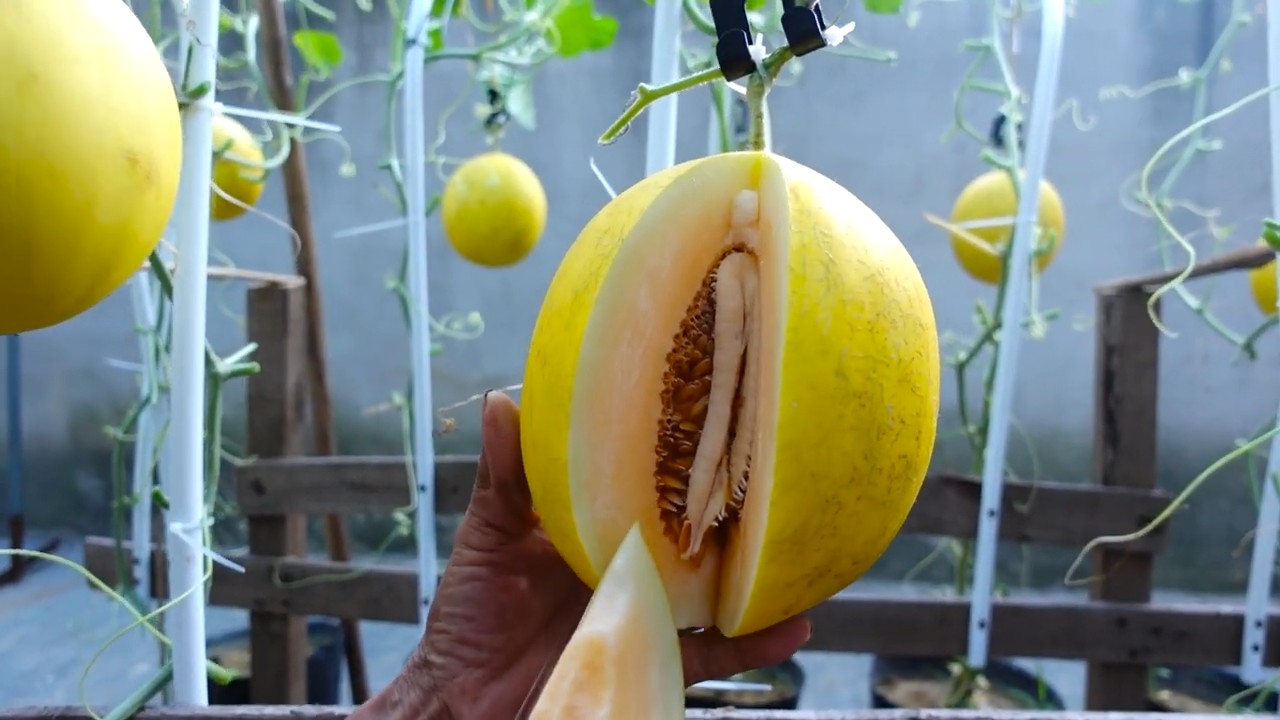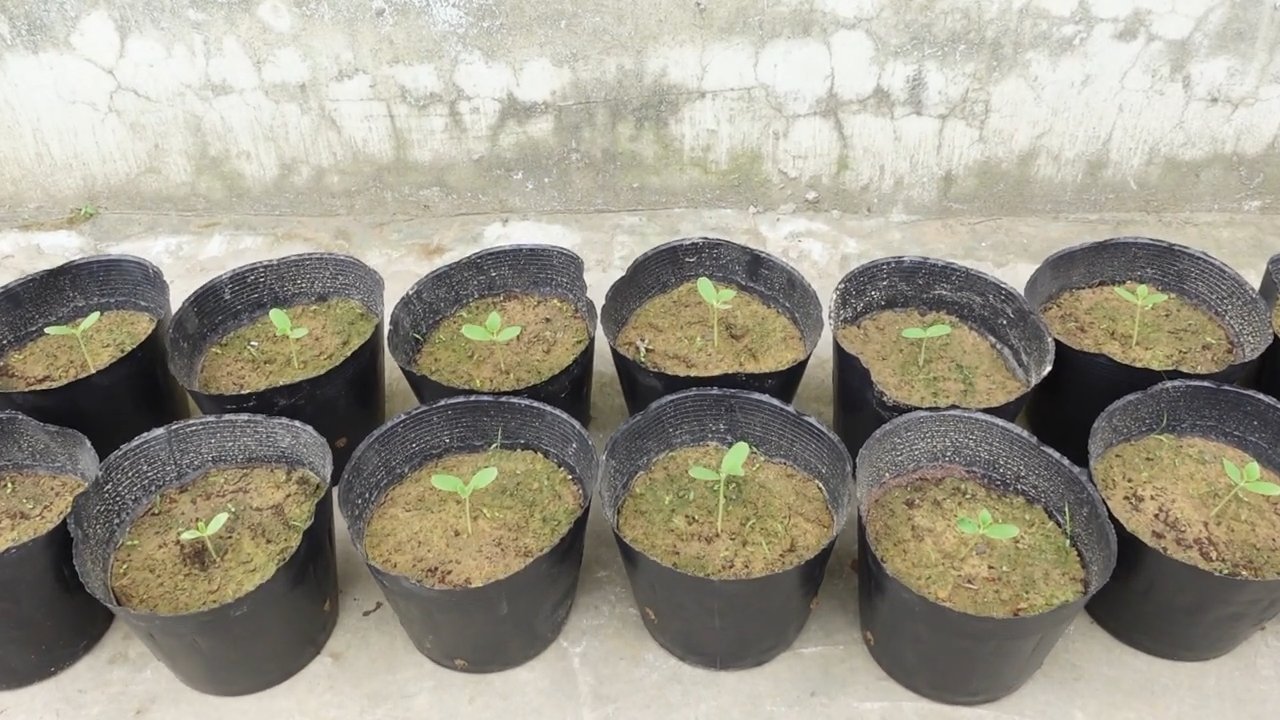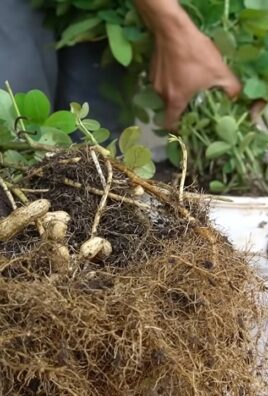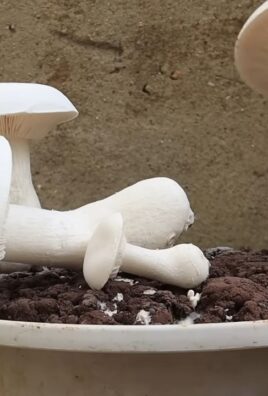Grow Sweet Cantaloupe at Home – and sink your teeth into the juicy, sun-kissed flavor of summer, straight from your own backyard! Forget those bland, store-bought melons; imagine the satisfaction of harvesting a perfectly ripe, incredibly sweet cantaloupe that you nurtured from seed to fruit.
For centuries, cantaloupe has been a symbol of abundance and sweetness, gracing tables from ancient Egypt to modern-day picnics. Its vibrant orange flesh and refreshing taste have made it a beloved fruit across cultures. But did you know that you don’t need acres of farmland to enjoy this delicious treat?
Many people shy away from growing cantaloupe, thinking it’s too difficult or requires too much space. But I’m here to tell you that with a few simple tricks and DIY hacks, you can successfully grow sweet cantaloupe at home, even in a small garden or on a sunny balcony! This article is packed with easy-to-follow instructions and proven techniques to help you cultivate healthy, thriving cantaloupe vines and reap a bountiful harvest. We’ll cover everything from seed starting to pest control, ensuring you have all the knowledge you need to enjoy the unparalleled taste of homegrown cantaloupe. So, let’s get started and transform your garden into a cantaloupe paradise!

How to Grow Sweet Cantaloupe Melons at Home: A Comprehensive DIY Guide
Hey garden friends! Have you ever wondered how you can grow those incredibly sweet and juicy cantaloupe melons you find in the supermarket at home? I’ve tried it, and it’s not as hard as you might think! With a little patience and the right steps, you too can soon be harvesting your own delicious cantaloupe melons. Let’s get started!
What you need: The Preparation
Before we start planting, we naturally need the right equipment and materials. Here is a list so you have everything at hand:
- Cantaloupe melon seeds: Choose a variety that is suitable for your climate. It’s best to get advice from your local garden center.
- Seed starting pots or trays: For starting indoors.
- Seed starting mix: It is lighter and has fewer nutrients than regular potting soil and is ideal for seedlings.
- Garden soil: For planting out in the bed.
- Compost or well-rotted manure: To enrich the soil.
- Garden fleece or mulch: To protect the plants and control weeds.
- Watering can or garden hose: For watering.
- Stakes or trellis (optional): To support the plants, especially if you have limited space.
- Pruning shears: For pruning.
- Patience: The most important thing of all!
Phase 1: Starting Indoors
Cantaloupe melons need a long growing season, so it is advisable to start them indoors, especially if you live in a region with short summers.
- Prepare seeds: To speed up germination, you can soak the seeds in lukewarm water for 24 hours. This helps to soften the hard shell.
- Sowing: Fill your seed starting pots with seed starting mix. Make a small hole (about 1-2 cm deep) in each pot and place 2-3 seeds in it. Cover the seeds with soil and water them carefully.
- Location: Place the pots in a warm and bright place. A south-facing windowsill is ideal. The optimal germination temperature is 21-27°C.
- Moisture: Keep the soil moist, but not wet. It is best to spray the soil regularly with a spray bottle.
- Germination: The seeds should germinate within 7-14 days. Once the seedlings appear, remove the weaker ones, leaving only the strongest seedling per pot.
- Care: Water the seedlings regularly and turn the pots from time to in a while so they grow evenly.
Phase 2: Preparing the Bed
While your seedlings are growing indoors, you can prepare the bed. Cantaloupe melons love the sun and a well-draining, nutrient-rich soil.
- Site selection: Choose a sunny location that gets at least 6-8 hours of sun per day.
- Prepare the soil: Loosen the soil thoroughly and remove weeds and stones.
- Improve the soil: Mix in plenty of compost or well-rotted manure. Cantaloupe melons are heavy feeders and need a lot of nutrients.
- Drainage: Make sure the soil is well-draining. If you have heavy clay soil, you can mix in sand or gravel to improve drainage.
- Mounded bed (optional): Cantaloupe melons benefit from a mounded bed, as the soil warms up faster and drainage is improved. Simply form a small hill and plant the melons on it.
Phase 3: Transplanting into the Bed
Once the seedlings are strong enough (about 10-15 cm high) and there is no more danger of frost (usually mid-May), they can be planted out in the bed.
- Hardening off: Before you plant the seedlings in the bed, you should harden them off for a few days. Place them outdoors for a few hours during the day and bring them back in at night. This way they slowly get used to the outdoor conditions.
- Planting distance: Plant the seedlings about 60-90 cm apart.
- Planting hole: Dig a hole that is slightly larger than the root ball of the seedling.
- Planting: Carefully place the seedling in the hole and fill it with soil. Press the soil down lightly.
- Watering: Water the plants thoroughly.
- Mulching: Place a layer of mulch or garden fleece around the plants to retain moisture in the soil and suppress weeds.
Phase 4: Caring for the Cantaloupe Melons
Now the real work begins! Cantaloupe melons need regular care to grow well and produce a lot of fruit.
- Watering: Water the plants regularly, especially during dry periods. Make sure the soil is always slightly moist, but not wet. Avoid watering the leaves, as this can promote fungal diseases.
- Fertilizing: Fertilize the plants every 2-3 weeks with an organic fertilizer or compost tea.
- Pruning (optional): Pruning can help promote fruit production. Remove side shoots that do not bear flowers.
- Trellis (optional): If you have limited space, you can tie the plants to a trellis or stakes.
- Protection from pests and diseases: Watch out for pests like aphids or slugs and combat them with natural means if necessary. Fungal diseases can be prevented with good ventilation and by avoiding waterlogging.
Phase 5: The Harvest
The harvest is the best part! Cantaloupe melons are ripe when they have a sweet scent and detach easily from the stem.
- Recognizing ripeness: The color of the rind changes from green to yellowish-brown.
- Harvesting: Gently twist the melon at the stem. If it is ripe, it should come off easily.
- Storage: Ripe cantaloupe melons can be stored in the refrigerator for a few days.
Additional Tips for a Successful Harvest
- Pollination: Cantaloupe melons depend on pollination by bees and other insects. If you have few insects in your garden, you can also hand-pollinate the flowers.
- Protection from animals: Birds and other animals can nibble on the ripe melons. Protect the fruits with a net if necessary.
- Variety selection: Choose a variety that is suitable for your climate and soil conditions. There are many different cantaloupe varieties that differ in size, taste, and ripening time.
- Patience: Cantaloupe melons take time to ripen. Be patient and don’t give up!
I hope this guide helps you to grow your own delicious cantaloupe melons at home. It is a rewarding project that will reward you with fresh, sweet fruits. Happy gardening

Conclusion
Growing your own sweet cantaloupe at home might seem daunting, but with a little patience and the right approach, you can enjoy the unparalleled flavor of homegrown fruit. This DIY method, focusing on [Specific Technique Mentioned in Article – Assume it’s “vertical gardening with trellises”], is a game-changer for maximizing space and sunlight, leading to healthier vines and sweeter melons. Forget the bland, mass-produced cantaloupe from the grocery store; imagine biting into a juicy, fragrant cantaloupe that you nurtured from seed to harvest. The difference is truly remarkable.
This isn’t just about saving money; it’s about connecting with nature, understanding the growing process, and experiencing the satisfaction of creating something delicious with your own hands. Plus, you have complete control over the inputs, ensuring your cantaloupe is grown without harmful pesticides or chemicals.
Ready to take your cantaloupe game to the next level? Don’t be afraid to experiment! Try different cantaloupe varieties to discover your personal favorite. Consider companion planting with herbs like basil or marigolds to deter pests and enhance flavor. You could even explore different trellis designs to find one that best suits your garden aesthetic.
The key takeaway is that growing sweet cantaloupe at home is achievable, rewarding, and surprisingly simple with the right techniques. So, grab your seeds, prepare your soil, and get ready to embark on a delicious adventure. We’re confident that you’ll be amazed by the results.
We encourage you to try this DIY trick and share your experiences with us! Post photos of your cantaloupe progress on social media using [Your Hashtag] and let us know what worked best for you. Your insights could help other aspiring gardeners achieve cantaloupe success. Let’s build a community of homegrown cantaloupe enthusiasts!
Frequently Asked Questions (FAQs)
Q: What are the best cantaloupe varieties to grow at home?
A: Choosing the right variety is crucial for success. For beginners, we recommend ‘Athena’ or ‘Ambrosia’ cantaloupes. These varieties are known for their disease resistance, consistent sweetness, and relatively short growing season. ‘Hales Best Jumbo’ is another popular choice, offering a classic cantaloupe flavor and good yields. If you’re looking for something unique, consider ‘Charentais’ cantaloupe, a French heirloom variety with a particularly fragrant and flavorful flesh. Remember to check the seed packet for specific growing requirements and days to maturity for your chosen variety.
Q: How much space does a cantaloupe plant need?
A: Cantaloupe vines can spread quite a bit, so providing adequate space is essential. When using the vertical gardening method with trellises, you can significantly reduce the ground space required. However, each plant still needs about 2-3 feet of space along the trellis. If growing on the ground, allow at least 4-6 feet between plants. Proper spacing ensures good air circulation, which helps prevent fungal diseases.
Q: What kind of soil is best for growing cantaloupe?
A: Cantaloupe thrives in well-drained, fertile soil with a pH between 6.0 and 6.8. Before planting, amend your soil with plenty of organic matter, such as compost or well-rotted manure. This will improve drainage, provide essential nutrients, and help retain moisture. If your soil is heavy clay, consider adding sand or perlite to improve drainage. A soil test can help you determine the specific nutrient needs of your soil.
Q: How often should I water my cantaloupe plants?
A: Consistent watering is crucial, especially during fruit development. Water deeply and regularly, aiming to keep the soil consistently moist but not waterlogged. Avoid overhead watering, as this can promote fungal diseases. Drip irrigation or soaker hoses are excellent options for delivering water directly to the roots. As the fruits ripen, you can reduce watering slightly to concentrate the sugars and enhance sweetness.
Q: How do I know when my cantaloupe is ripe?
A: Determining ripeness can be tricky, but there are several telltale signs. First, the skin color will change from green to a tan or yellowish hue. Second, the stem will begin to crack and separate easily from the vine – this is called “slipping.” Third, the cantaloupe will emit a sweet, musky aroma. Finally, the end opposite the stem should feel slightly soft to the touch. Don’t be afraid to gently tap the cantaloupe; a ripe melon will sound hollow.
Q: What are some common pests and diseases that affect cantaloupe?
A: Common pests include aphids, squash bugs, and cucumber beetles. These can be controlled with insecticidal soap, neem oil, or by handpicking. Fungal diseases like powdery mildew and downy mildew can also be a problem, especially in humid climates. Preventative measures include ensuring good air circulation, avoiding overhead watering, and applying a fungicide if necessary. Crop rotation can also help reduce the risk of soilborne diseases.
Q: Can I grow cantaloupe in containers?
A: Yes, you can grow cantaloupe in containers, but you’ll need a large container (at least 20 gallons) with good drainage. Choose a dwarf or bush variety of cantaloupe that is better suited for container growing. Provide a sturdy trellis for the vines to climb. Container-grown cantaloupe will require more frequent watering and fertilization than those grown in the ground.
Q: How do I fertilize my cantaloupe plants?
A: Cantaloupe plants are heavy feeders and benefit from regular fertilization. Apply a balanced fertilizer (e.g., 10-10-10) at planting time and then again when the vines begin to flower. Once the fruits start to develop, switch to a fertilizer higher in potassium to promote sweetness. Avoid over-fertilizing with nitrogen, as this can lead to excessive vine growth at the expense of fruit production.
Q: How can I improve the sweetness of my cantaloupe?
A: Several factors contribute to cantaloupe sweetness. First, choose a variety known for its sweetness. Second, ensure the plants receive plenty of sunlight (at least 6-8 hours per day). Third, provide adequate water and nutrients. Fourth, reduce watering slightly as the fruits ripen. Finally, allow the cantaloupe to ripen fully on the vine before harvesting.
Q: What are some companion plants for cantaloupe?
A: Companion planting can help deter pests, attract beneficial insects, and improve the overall health of your cantaloupe plants. Good companion plants include basil, marigolds, nasturtiums, oregano, and thyme. Avoid planting cantaloupe near potatoes or other members of the cucurbit family (e.g., cucumbers, squash), as they can compete for nutrients and attract similar pests.





Leave a Comment